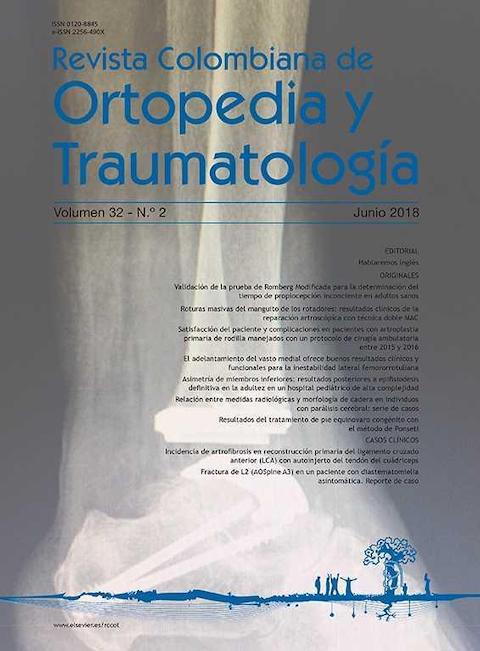Asimetría de miembros inferiores: resultados posteriores a epifisiodesis definitiva en la adultez en un hospital pediátrico de alta complejidad
DOI:
https://doi.org/10.1016/j.rccot.2017.09.004Palabras clave:
asimetría de miembros inferiores, epifisiodesis, complicacionesResumen
Introducción: En nuestro centro, el tratamiento quirúrgico más utilizado en niños con asimetría de longitud de miembros inferiores es la epifisiodesis definitiva percutánea. El objetivo del estudio es describir los resultados hasta la madurez esquelética y las complicaciones en niños con asimetría de miembros inferiores, tratados con epifisiodesis definitiva, en un hospital de pediatría de alta complejidad desde el año 1993, así como analizar variables relacionadas con el porcentaje de corrección.
Materiales y métodos: Es un estudio descriptivo y retrospectivo por revisión radiológica e historias clínicas. Se incluyó a todos los pacientes con diagnóstico de asimetría de miembros inferiores posterior a epifisiodesis definitiva como único tratamiento con radiografía hasta la madurez esquelética. Se realizó análisis descriptivo y análisis de regresión entre el porcentaje de corrección (AI - AF/AI) y las variables predictoras de sexo, etiología, asimetría inicial, predicha y en la adultez, edad de inicio del seguimiento y quirúrgica, método de predicción y desarrollo puberal. Se analizaron las complicaciones.
Resultados: 29 pacientes; 16 varones, y 21 congénitas. Mediana de edad a la cirugía: 12,1 (r: 10,8-13,6) y 13,7 (r: 11,4-15,2) años en mujeres y varones, respectivamente. La asimetría en la adultez fue inferior a 2 cm en el 69%. El rango del porcentaje de corrección fue del 2,6 al 106,5%, lo que se asoció negativamente a la pubertad avanzada (coeficiente: -23,9; p = 0,025) y positivamente a Moseley (coeficiente: 38,9; p = 0,056). Complicaciones: alteración del eje en zona 1 (10%).
Discusión: La epifisiodesis definitiva percutánea fue una herramienta eficaz y segura para el tratamiento de asimetrías de longitud de miembros inferiores en nuestros pacientes. Hacemos hincapié en la evaluación del desarrollo puberal durante el seguimiento para optimizar los resultados en la adultez.
Nivel de evidencia clínica: Nivel IV.
Descargas
Referencias bibliográficas
Phemister DB. Epiphysiodesis for equalizing the length of the lower extremities and for correcting other deformities of the skeleton. Mem Acad Chir. 1950;76:758-63.
Bowen JR, Johnson WJ. Percutaneous epiphysiodesis. Clin Orthop Relat Res. 1984;190:170-3. https://doi.org/10.1097/00003086-198411000-00027
Canale ST, Russell TA, Holcomb RL. Percutaneous epiphysiodesis: experimental study and preliminary clinical results. J Pediatr Orthop. 1986;6:150-6. https://doi.org/10.1097/01241398-198603000-00006
Blount WP, Clarke GR. Control of bone growth by epiphyseal stapling; a preliminary report. J Bone Joint Surg Am. 1949;31:464-78. https://doi.org/10.2106/00004623-194931030-00002
Métaizeau JP, Wong-Chung J, Bertrand H, Pasquier P. Percutaneous epiphysiodesis using transphyseal screws (PETS). J Pediatr Orthop. 1998;18:363-9. https://doi.org/10.1097/01241398-199805000-00018
Stevens PM. Guided growth for angular correction: A preliminary series using a tension band plate. J Pediatr Orthop. 2007;27:253-9. https://doi.org/10.1097/BPO.0b013e31803433a1
Makarov MR, Dunn SH, Singer DE, Rathjen KE, Ramo BA, Chukwunyerenwa CK, et al. Complications associated with epiphysiodesis for management of leg length discrepancy. J Pediatr Orthop. 2016.
Inan M, Chan G, Littleton AG, Kubiak P, Bowen R. Efficacy and safety of percutaneous epiphysiodesis. J Pediatr Orthop. 2008;28:648-51. https://doi.org/10.1097/BPO.0b013e3181832475
Lykissasa MG, Jaina VV, Manickamb V, Nathana S, Eismanna EA, McCarthya JJ. Guided growth for the treatment of limb length discrepancy: a comparative study of the three most commonly used surgical techniques. J Pediatr Orthop. 2013;22:311-7. https://doi.org/10.1097/BPB.0b013e32836132f0
Bowen JR, Percutaneous distal femoral o proximal tibial epiphysiodesis. En: Flynn JM, Wiesel SW, editores. Operative Techniques in Pediatric Orthopedics. Philadelphia: Lippincott Williams & Wilkins; 2012.
Shabtai L, Herzenberg JE. Limits of growth modulation using tension band plates in the lower extremities. J Am Acad Orthop Surg. 2016;24:691-701. https://doi.org/10.5435/JAAOS-D-14-00234
Little DG, Nigo L, Aiona MD. Deficiencies of current methods for the timing of epiphysiodesis. J Pediatr Orthop. 1996;16:173-9. https://doi.org/10.1097/01241398-199603000-00007
Moseley CF. A straight-line graph for leg-length discrepancies. J Bone Joint Surg Am. 1977;59:174-9. https://doi.org/10.2106/00004623-197759020-00006
Tachdjian MO, Ortopedia pediátrica. Texas Scottish Rite Hospital for Children. 4th edition. Philadelphia: Saunders Elsevier; 1983.
Marshall WA, Tanner JM, Puberty. En: Falkner F, Tanner JM, editores. Human growth: a comprehensive treatise. Volume 2. Postnatal growth and neurobiology. New York: Plenum Publishing; 1986. https://doi.org/10.1007/978-1-4899-0522-2_8
Sánchez S, Ortega X, Baar A, Lillo S, De la Maza A, Moënne K, Escaffi JA, et al. Asimetría de extremidades inferiores: evaluación por imágenes en la edad pediátrica. Revista Chilena de Radiología. 2013;19:177-86. https://doi.org/10.4067/S0717-93082013000400007
Bayhan IA, Karatas AF, Rogers KJ, Bowen JR, Thacker MM. Comparing percutaneous physeal epiphysiodesis and eight-plate epiphysiodesis for the treatment of limb length discrepancy. J Pediatr Orthop. 2015;37:323-7. https://doi.org/10.1097/BPO.0000000000000647
Song MH, Choi ES, Park MS, Yoo WJ, Chung CY, Choi IH, et al. Percutaneous epiphysiodesis using transphyseal screws in the management of leg length discrepancy: optimal operation timing and techniques to avoid complications. J Pediatr Orthop. 2015;35:89-93. https://doi.org/10.1097/BPO.0000000000000214
Mielke CH, Stevens PM. Hemiepiphyseal stapling for knee deformities in children younger than 10 years: A preliminary report. J Pediatr Orthop. 1996;16:423-9. https://doi.org/10.1097/01241398-199607000-00002
Ministerio de Justicia y Derechos Humanos. Presidencia de la nación argentina. Ley 25.326. Protección de los datos personales, 2000.
Campens C, Mousny M, Docquier PL. Comparison of three surgical epiphysiodesis techniques for the treatment of lower limb length discrepancy. Acta Orthop Belg. 2010;76:226-33.
Kemnitz S, Moens P, Fabry G. Percutaneous epiphysiodesis for leg length discrepancy. J Pediatr Orthop B. 2003;12:69-71. https://doi.org/10.1097/01202412-200301000-00013
Koczewski P, Fryzowicz A. Phemister epiphysiodesis in leg length inequality treatment-evaluative outcome analysis. Ortop Traumatol Rehabil. 2013;15:315-23. https://doi.org/10.5604/15093492.1073830
Gorman TM, Vanderwerff R, Pond M, Mac Williams B, Santora SD. Mechanical axis following staple epiphysiodesis for limb-length inequality. J Bone Joint Surg Am. 2009;91:2430-9. https://doi.org/10.2106/JBJS.H.00896
Dewaele J, Fabry G. The timing of epiphysiodesis. A comparative study between the use of the method of Anderson and Green and the Moseley Chart. Acta Orthop Belg. 1992;58:43-7.









